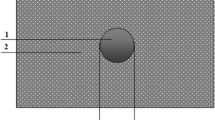Conclusion
Solutions for the elastic characteristics and the creep functions of a composite containing hollow spherical fillers as applies to the four-phase nucleus/jacket/binder/equivalent-homogeneous-material model are obtained in the study when the method of self-correspondence is used. It is demonstrated that if the two-stage approach (when the elastic characteristics of the nucleus + jacket system, and the composite are calculated in the first and second stages, respectively) yields an exact solution for the bulk modulus K* of the composite, it is highly approximate when the shear modulus G* of the composite is determined. The error of determination of G* increases considerably (by a factor of 2–2.5 when μ = 0.4) when Kerner's approximate solution (2) is used in lieu of solution (8) for the three-phase model within the framework of the two stage approach. Dzenis and Maksimov [5] establish by comparison with experimental data that the four-phase model provides a rather exact solution for the elastic modulus of a composite when the bulk content of hollow spheres μ ≤ 0.4. It is also demonstrated that use of Kerner's approximate solution (2) within the framework of the two-stage approach in predicting the creep of a composite yields an inadmissibly high error in the region of the principal relaxation transition of the binder from the glassy to the highly elastic state.
Similar content being viewed by others
References
E. N. Kerner, “The elastic and thermoelastic properties of composite media,” Proc. Phys. Soc. Sec. B,69, 808–813 (August, 1956).
J. C. Smith, “Correction and extension of van der Poel's method for calculating the shear modulus of a particulate composite,” J. Res. Mat. Bureau Standards. A. Phys. Chem.,78A, No. 3, 355–361 (1974).
R. M. Christensen and K. H. Lo, “Solution for effective shear properties in three-phase sphere and cylinder models,” J. Mech. Phys. Solids,27, No. 4, 315–330 (1979).
T. G. Richard, “The mechanical behavior of a solid microsphere-filled composite,” J. Compos. Mater.,9, 108–113 (April, 1975).
Yu. A. Dzenis and R. D. Maksimov, “Characteristics of the elastic and thermophysical properties of hollow-sphere composites,” Mekh. Kompozitn. Mater., No. 3, 403–411 (1991).
A. D. Kiselev and V. A. Kochetkov, “Creep of epoxy binder during thermal cycling,” Mekh. Kompozitn. Mater., No. 4, 557–561 (1992).
V. A. Kochetkov, “Numerical inversion of the Laplace transform using quadrature interpolation equations,” Algor. Progr., No. 1, 46 (1985).
Author information
Authors and Affiliations
Additional information
This work was sponsored at the Iberoamericana University in 1993 by the Mexican National Council of Science and Technology (CONACYT).
Translated from Mekhanika Kompozitnykh Materialov, Vol. 30, No. 2, pp. 177–188, March–April, 1994.
Rights and permissions
About this article
Cite this article
Kochetkov, V.A. Calculation of elastic characteristics and creep functions of hollow-sphere plastics by the effective medium method. Mech Compos Mater 30, 121–130 (1994). https://doi.org/10.1007/BF00635843
Received:
Issue Date:
DOI: https://doi.org/10.1007/BF00635843




